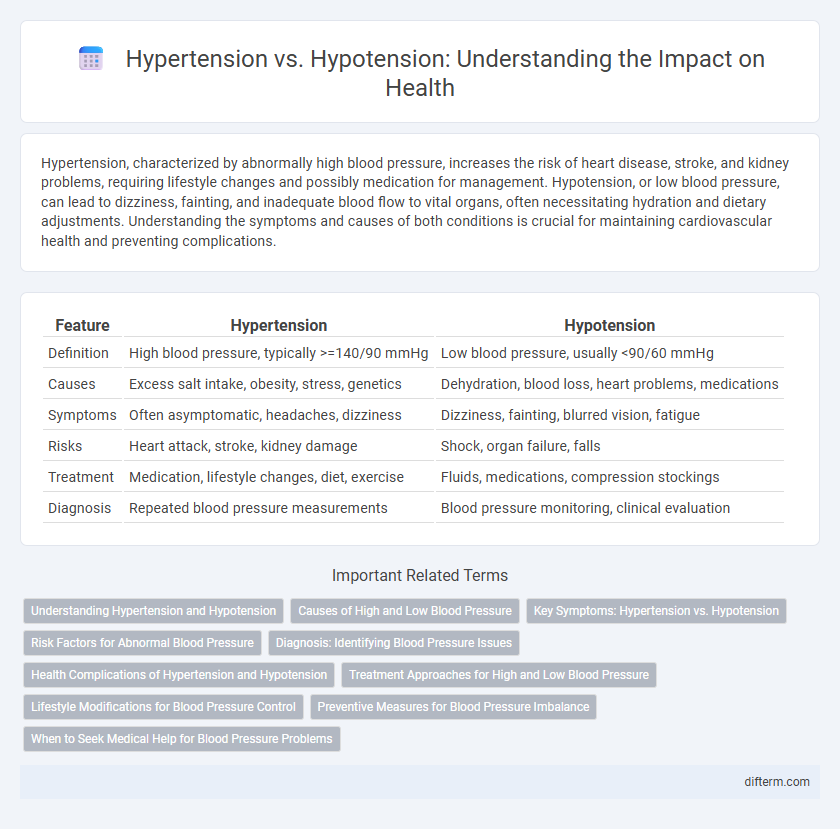Hypertension, characterized by abnormally high blood pressure, increases the risk of heart disease, stroke, and kidney problems, requiring lifestyle changes and possibly medication for management. Hypotension, or low blood pressure, can lead to dizziness, fainting, and inadequate blood flow to vital organs, often necessitating hydration and dietary adjustments. Understanding the symptoms and causes of both conditions is crucial for maintaining cardiovascular health and preventing complications.
Table of Comparison
| Feature | Hypertension | Hypotension |
|---|---|---|
| Definition | High blood pressure, typically >=140/90 mmHg | Low blood pressure, usually <90/60 mmHg |
| Causes | Excess salt intake, obesity, stress, genetics | Dehydration, blood loss, heart problems, medications |
| Symptoms | Often asymptomatic, headaches, dizziness | Dizziness, fainting, blurred vision, fatigue |
| Risks | Heart attack, stroke, kidney damage | Shock, organ failure, falls |
| Treatment | Medication, lifestyle changes, diet, exercise | Fluids, medications, compression stockings |
| Diagnosis | Repeated blood pressure measurements | Blood pressure monitoring, clinical evaluation |
Understanding Hypertension and Hypotension
Hypertension, defined as consistently elevated blood pressure above 130/80 mmHg, increases the risk of heart disease, stroke, and kidney failure, necessitating regular monitoring and lifestyle modifications. Hypotension occurs when blood pressure falls below 90/60 mmHg, potentially causing dizziness, fainting, and inadequate blood flow to organs. Understanding the distinct causes, symptoms, and health impacts of hypertension and hypotension is critical for effective diagnosis and treatment.
Causes of High and Low Blood Pressure
Hypertension, or high blood pressure, often results from factors such as excessive salt intake, obesity, chronic stress, and genetic predisposition affecting arterial resistance. Hypotension, or low blood pressure, commonly arises due to dehydration, heart problems like bradycardia, endocrine disorders such as Addison's disease, or severe infection leading to septic shock. Both conditions involve disruptions in vascular tone and fluid balance, impacting overall cardiovascular health.
Key Symptoms: Hypertension vs. Hypotension
Key symptoms of hypertension include persistent headaches, dizziness, and blurred vision due to increased arterial pressure. Hypotension is characterized by symptoms such as fainting, fatigue, and cold, clammy skin resulting from low blood pressure. Recognizing these contrasting symptoms is crucial for timely diagnosis and effective management of both conditions.
Risk Factors for Abnormal Blood Pressure
Hypertension risk factors include obesity, excessive salt intake, chronic stress, and a family history of high blood pressure, which contribute to arterial stiffness and elevated cardiovascular strain. Hypotension is often linked to dehydration, prolonged bed rest, endocrine disorders, and certain medications that reduce blood volume or cardiac output. Both conditions increase the risk of heart disease, stroke, and organ damage if left unmanaged.
Diagnosis: Identifying Blood Pressure Issues
Accurate diagnosis of hypertension and hypotension relies on consistent blood pressure measurements using a sphygmomanometer. Hypertension is identified when systolic pressure exceeds 130 mmHg or diastolic pressure exceeds 80 mmHg in multiple readings, while hypotension is diagnosed when systolic pressure falls below 90 mmHg or diastolic pressure below 60 mmHg. Clinical assessment may include ambulatory blood pressure monitoring and evaluation of symptoms to distinguish between primary and secondary causes of blood pressure abnormalities.
Health Complications of Hypertension and Hypotension
Hypertension significantly increases the risk of severe health complications such as heart disease, stroke, kidney failure, and vision loss due to sustained high blood pressure damaging blood vessels and organs. Hypotension can lead to dizziness, fainting, and shock, potentially causing injury from falls and insufficient blood flow to critical organs like the brain and heart. Managing blood pressure abnormalities is crucial to preventing long-term damage and maintaining overall cardiovascular health.
Treatment Approaches for High and Low Blood Pressure
Treatment for hypertension typically includes lifestyle modifications such as a low-sodium diet, regular aerobic exercise, weight management, and pharmacological interventions like ACE inhibitors, beta-blockers, or diuretics to effectively lower elevated blood pressure. In contrast, hypotension treatment focuses on preventing symptoms through increased fluid and salt intake, compression stockings, and medications like fludrocortisone or midodrine to raise blood pressure when necessary. Accurate diagnosis and individualized therapy plans are essential to managing both conditions and preventing complications such as stroke or organ hypoperfusion.
Lifestyle Modifications for Blood Pressure Control
Lifestyle modifications play a crucial role in managing both hypertension and hypotension. For hypertension, reducing sodium intake, engaging in regular physical activity, maintaining a healthy weight, limiting alcohol consumption, and managing stress effectively can help lower elevated blood pressure levels. In cases of hypotension, staying hydrated, consuming balanced meals with sufficient salt, and avoiding sudden position changes assist in stabilizing low blood pressure and preventing symptoms like dizziness.
Preventive Measures for Blood Pressure Imbalance
Maintaining a balanced diet rich in potassium, magnesium, and low sodium helps regulate blood pressure and prevent hypertension and hypotension. Regular physical activity, stress management techniques like mindfulness, and routine blood pressure monitoring are crucial for early detection and control of blood pressure imbalances. Avoiding excessive alcohol intake and smoking further supports cardiovascular health and prevents fluctuations in blood pressure.
When to Seek Medical Help for Blood Pressure Problems
Seek medical help for hypertension if blood pressure readings consistently exceed 140/90 mmHg or if experiencing symptoms like severe headaches, chest pain, or shortness of breath. For hypotension, immediate medical attention is necessary when blood pressure drops below 90/60 mmHg accompanied by dizziness, fainting, or shock signs. Timely consultation with healthcare professionals prevents complications such as stroke, heart attack, or organ damage related to abnormal blood pressure levels.
Hypertension vs Hypotension Infographic

 difterm.com
difterm.com